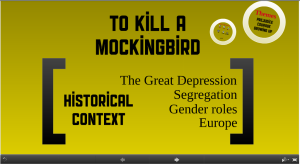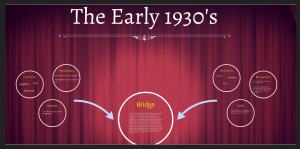Unit Objective
● Demonstrate an understanding of the plot structure
● Identify the central themes, providing evidence from the text
● Identify and analyze how imagery is used to create a setting
● Analyze and explain the growth of dynamic characters, providing evidence from the text
● Identify historical allusions within the text
● Identify examples of figurative language and symbolism within the text
● Identify examples of irony within the text
● Incorporate quoted material into written responses to a prompt
● Reflect on the damage caused by stereotyping and the benefits of trying to understand another’s perspective
Background and Rationale
This lesson creates anticipation for the study of To Kill a Mockingbird and builds students’ close reading skills. It also teaches them about historical allusions and how imagery and sensory details build a setting. Instead of these things being pointed out to the students, they will have the opportunity to discover them for themselves. They will scrutinize just a small portion of the novel so that they can focus on how the author’s word choice shapes their understanding of the setting.
Lesson Objectives
Objective |
Bloom’s Verb |
|---|---|
| Students will understand the historical context of To Kill a Mockingbird and identify historical allusions within the text. | Understanding |
| Students will be able to explain their own learning visually and verbally | Analyzing |
| Students will find imaginitive connections between ideas when composing their simile or metaphor and will consider aesthetics and design when making their prezi | Creating |
Bloom’s Taxonomy
Understanding
Common Core / State and District Standards
- CCSS.ELA-Literacy.CCRA.R.1
- CCSS.ELA-Literacy.RL.7.1
Technology Integration (ISTE) Standards
- 1.a. Apply existing knowledge to generate new ideas, products or processes
- 5.b. Exhibit a positive attitude toward using technology that supports collaboration learning productivity
- 6.a. Understand and use technology systems elaborate refine analyze and evaluate their own ideas in order to improve and maximize creative efforts (Think Creatively)
- Develop, implement and communicate new ideas to others effectively (Work Creatively with Others)
- Be open and responsive to new and diverse perspectives; incorporate group input and feedback into the work (Work Creatively with Others)
- Articulate thoughts and ideas effectively using oral, written and nonverbal communication skills in a variety of forms and contexts (Communicate Clearly)
- Listen effectively to decipher meaning including knowledge values attitudes and intentions
- Know when it is appropriate to listen and when to speak (Social and Cross-Cultural Skills)
- Conduct themselves in a respectable professional manner (Social and Cross-Cultural Skills)
- Use technology as a tool to research, organize, evaluate and communicate information (Apply Technology Effectively)
Lesson – Introduction
The teacher will motivate student interest with the first part of the 3-2-1 Bridge thinking routine. The teacher will write “the early 1930’s” on the board. Students will be instructed to think of everything they know about the topic and to then think of three words, two questions, and a metaphor/simile that relate to the topic. They will create a prezi (prezi.com) to record their thinking. Then they will share their thinking with the class and note commonalities and differences amongst the responses of their peers.
Lesson Activities and Procedures
Student Procedure |
Teacher Procedure |
Materials |
|---|---|---|
| Students will listen and take notes | The teacher will present the Historical Background Prezi | Click image |
Students will make the additions to their prezi, as directed by the teacherThe teacher will ask students to think about the information that was presented to them and to now add on to the prezi they started as part of the lesson introduction. They will think of another set of three words, two questions, and a metaphor/simile that relate to the topic. They will be encouraged to use the zooming capabilities of the prezi to demonstrate their changes in thinking
Students will engage positively in the discussion led by the teacherThe teacher will ask students to share their thinking with the class and note commonalities and differences amongst the responses of their peers. The teacher will also lead a discussion on how the responses connect to or shift from the initial responses. Students will make the additions to their prezi, as directed by the teacherThe teacher will instruct students to compose a paragraph on their prezi explaining how their new responses connected to or shifted from their initial responses.
Lesson – Closure
The students will read the following excerpt from the first chapter of To Kill a Mockingbird: Maycomb was an old town, but it was a tired old town when I first knew it. In rainy weather the streets turned to red slop; grass grew on the sidewalks, the courthouse sagged in the square. Somehow, it was hotter then: a black dog suffered on a summer’s day; bony mules hitched to Hoover carts flicked flies in the sweltering shade of the live oaks on the square. Men’s stiff collars wilted by nine in the morning. Ladies bathed before noon, after their three-o’clock naps, and by nightfall were like soft teacakes with frostings of sweat and sweet talcum. People moved slowly then. They ambled across the square, shuffled in and out of the stores around it, took their time about everything. A day was twenty-four hours long but seemed longer. There was no hurry, for there was nowhere to go, nothing to buy and no money to buy it with, nothing to see outside the boundaries of Maycomb County. But it was a time of vague optimism for some of the people: Maycomb County had recently been told that it had nothing to fear but fear itself. The teacher will ask students to identify the historical allusions in the excerpt based on what they have learned about the time period.





